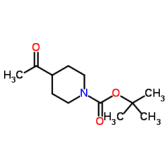您当前的位置:首页 > 前衍产品库 >
206989-61-9 1-叔丁氧羰基-4-乙酰基哌啶 >百科

生成产品海报
基本信息
CAS:206989-61-9
中文名称:1-叔丁氧羰基-4-乙酰基哌啶
英文名称:tert-Butyl 4-acetylpiperidine-1-carboxylate
常用名:1-Boc-4-乙酰基哌啶;1-N-BOC-4-乙酰基哌啶;N-BOC-4-乙酰基哌啶;4-乙酰基-1-哌啶羧酸-1,1-二甲基乙酯;4-乙酰基-哌啶-1-甲酸叔丁酯;
英文别名:N-Boc-4-acetylpiperidine, 1-piperidinecarboxylicacid,4-acetyl-,1,1-dimethylethylester, tert-Butyl4-acetylpiperidine-1-carboxylate, tert-Butyl-4-acetylpiperidin-1-carboxylat, 1-tert-Butoxycarbonyl-4-acetylpiperidine, 4-Acetyl-Piperidine-1-CarboxylicAcidTert-ButylEster
分子式:C12H21NO3
分子量:227.3
中文名称:1-叔丁氧羰基-4-乙酰基哌啶
英文名称:tert-Butyl 4-acetylpiperidine-1-carboxylate
常用名:1-Boc-4-乙酰基哌啶;1-N-BOC-4-乙酰基哌啶;N-BOC-4-乙酰基哌啶;4-乙酰基-1-哌啶羧酸-1,1-二甲基乙酯;4-乙酰基-哌啶-1-甲酸叔丁酯;
英文别名:N-Boc-4-acetylpiperidine, 1-piperidinecarboxylicacid,4-acetyl-,1,1-dimethylethylester, tert-Butyl4-acetylpiperidine-1-carboxylate, tert-Butyl-4-acetylpiperidin-1-carboxylat, 1-tert-Butoxycarbonyl-4-acetylpiperidine, 4-Acetyl-Piperidine-1-CarboxylicAcidTert-ButylEster
分子式:C12H21NO3
分子量:227.3
物理化学性质
密度 1.1±0.1 g/cm3
沸点 312.4±35.0 °C at 760 mmHg
分子式 C12H21NO3
分子量 227.300
闪点 142.7±25.9 °C
精确质量 227.152145
PSA 46.61000
LogP 1.17
蒸汽压 0.0±0.7 mmHg at 25°C
折射率 1.474
储存条件 2-8°C
沸点 312.4±35.0 °C at 760 mmHg
分子式 C12H21NO3
分子量 227.300
闪点 142.7±25.9 °C
精确质量 227.152145
PSA 46.61000
LogP 1.17
蒸汽压 0.0±0.7 mmHg at 25°C
折射率 1.474
储存条件 2-8°C
安全信息
[ 危险品标志 ]:T
[ 危险类别码 ]:25
[ 安全说明 ]:45HazardClassIRRITANT
MSDS
SECTION 1: Identification of the substance/mixture and of the company/undertaking
Product identifiers
Product name: Tert-Butyl 4-Acetylpiperidine-1-Carboxylate
REACH No.: A registration number is not available for this substance as the substance
or its uses are exempted from registration, the annual tonnage does not
require a registration or the registration is envisaged for a later
registration deadline.
Relevant identified uses of the substance or mixture and uses advised against
Identified uses: Laboratory chemicals, Manufacture of substances
SECTION 2: Hazards identification
Classification of the substance or mixture
Classification according to Regulation (EC) No 1272/2008
Acute toxicity, Oral (Category 3), H301
For the full text of the H-Statements mentioned in this Section, see Section 16.
Classification according to EU Directives 67/548/EEC or 1999/45/EC
T ToxicR25
For the full text of the R-phrases mentioned in this Section, see Section 16.
Label elements
Labelling according Regulation (EC) No 1272/2008
Pictogram
Signal wordDanger
Hazard statement(s)
H301Toxic if swallowed.
Precautionary statement(s)
P301 + P310IF SWALLOWED: Immediately call a POISON CENTER or doctor/
physician.
Supplemental Hazardnone
Statements
Other hazards
This substance/mixture contains no components considered to be either persistent, bioaccumulative and
toxic (PBT), or very persistent and very bioaccumulative (vPvB) at levels of 0.1% or higher.
SECTION 3: Composition/information on ingredients
Substances
Molecular weight: 227,3 g/mol
Hazardous ingredients according to Regulation (EC) No 1272/2008
ComponentClassificationConcentration
Tert-Butyl 4-Acetylpiperidine-1-Carboxylate
Acute Tox. 3; H301<= 100 %
Hazardous ingredients according to Directive 1999/45/EC
ComponentClassificationConcentration
Tert-Butyl 4-Acetylpiperidine-1-Carboxylate
T, R25<= 100 %
For the full text of the H-Statements and R-Phrases mentioned in this Section, see Section 16
SECTION 4: First aid measures
Description of first aid measures
General advice
Consult a physician. Show this safety data sheet to the doctor in attendance.
If inhaled
If breathed in, move person into fresh air. If not breathing, give artificial respiration. Consult a physician.
In case of skin contact
Wash off with soap and plenty of water. Take victim immediately to hospital. Consult a physician.
In case of eye contact
Flush eyes with water as a precaution.
If swallowed
Never give anything by mouth to an unconscious person. Rinse mouth with water. Consult a physician.
Most important symptoms and effects, both acute and delayed
The most important known symptoms and effects are described in the labelling (see section 2.2) and/or in
section 11
Indication of any immediate medical attention and special treatment needed
No data available
SECTION 5: Firefighting measures
Extinguishing media
Suitable extinguishing media
Use water spray, alcohol-resistant foam, dry chemical or carbon dioxide.
Special hazards arising from the substance or mixture
Nature of decomposition products not known.
Advice for firefighters
Wear self-contained breathing apparatus for firefighting if necessary.
Further information
No data available
SECTION 6: Accidental release measures
Personal precautions, protective equipment and emergency procedures
Wear respiratory protection. Avoid dust formation. Avoid breathing vapours, mist or gas. Ensure
adequate ventilation. Evacuate personnel to safe areas. Avoid breathing dust.
For personal protection see section 8.
Environmental precautions
Prevent further leakage or spillage if safe to do so. Do not let product enter drains.
Methods and materials for containment and cleaning up
Pick up and arrange disposal without creating dust. Sweep up and shovel. Keep in suitable, closed
containers for disposal.
Reference to other sections
For disposal see section 13.
SECTION 7: Handling and storage
Precautions for safe handling
Avoid contact with skin and eyes. Avoid formation of dust and aerosols.
Provide appropriate exhaust ventilation at places where dust is formed.
For precautions see section 2.2.
Conditions for safe storage, including any incompatibilities
Store in cool place. Keep container tightly closed in a dry and well-ventilated place.
Storage class (TRGS 510): Non-combustible, acute toxic Cat.3 / toxic hazardous materials or hazardous
materials causing chronic effects
Specific end use(s)
Apart from the uses mentioned in section 1.2 no other specific uses are stipulated
SECTION 8: Exposure controls/personal protection
Control parameters
Components with workplace control parameters
Exposure controls
Appropriate engineering controls
Avoid contact with skin, eyes and clothing. Wash hands before breaks and immediately after handling
the product.
Personal protective equipment
Eye/face protection
Face shield and safety glasses Use equipment for eye protection tested and approved under
appropriate government standards such as NIOSH (US) or EN 166(EU).
Skin protection
Handle with gloves. Gloves must be inspected prior to use. Use proper glove removal technique
(without touching glove's outer surface) to avoid skin contact with this product. Dispose of
contaminated gloves after use in accordance with applicable laws and good laboratory practices.
Wash and dry hands.
The selected protective gloves have to satisfy the specifications of EU Directive 89/686/EEC and
the standard EN 374 derived from it.
Body Protection
Complete suit protecting against chemicals, The type of protective equipment must be selected
according to the concentration and amount of the dangerous substance at the specific workplace.
Respiratory protection
Where risk assessment shows air-purifying respirators are appropriate use a full-face particle
respirator type N99 (US) or type P2 (EN 143) respirator cartridges as a backup to engineering
controls. If the respirator is the sole means of protection, use a full-face supplied air respirator. Use
respirators and components tested and approved under appropriate government standards such
as NIOSH (US) or CEN (EU).
Control of environmental exposure
Prevent further leakage or spillage if safe to do so. Do not let product enter drains.
SECTION 9: Physical and chemical properties
Information on basic physical and chemical properties
a) AppearanceForm: solid
b) OdourNo data available
c) Odour ThresholdNo data available
d) pHNo data available
e) Melting point/freezingNo data available
point
f) Initial boiling point and No data available
boiling range
g) Flash pointNo data available
h) Evaporation rateNo data available
i) Flammability (solid, gas) No data available
j) Upper/lowerNo data available
flammability or
explosive limits
k) Vapour pressureNo data available
l) Vapour densityNo data available
m) Relative densityNo data available
n) Water solubilityNo data available
o) Partition coefficient: n- No data available
octanol/water
p) Auto-ignitionNo data available
temperature
q) DecompositionNo data available
temperature
r) ViscosityNo data available
s) Explosive propertiesNo data available
t) Oxidizing propertiesNo data available
Other safety information
No data available
SECTION 10: Stability and reactivity
Reactivity
No data available
Chemical stability
Stable under recommended storage conditions.
Possibility of hazardous reactions
No data available
Conditions to avoid
No data available
Incompatible materials
No data available
Hazardous decomposition products
In the event of fire: see section 5
SECTION 11: Toxicological information
Information on toxicological effects
Acute toxicity
No data available
Skin corrosion/irritation
No data available
Serious eye damage/eye irritation
No data available
Respiratory or skin sensitisation
No data available
Germ cell mutagenicity
No data available
Carcinogenicity
IARC:No component of this product present at levels greater than or equal to 0.1% is identified as
probable, possible or confirmed human carcinogen by IARC.
Reproductive toxicity
No data available
Specific target organ toxicity - single exposure
No data available
Specific target organ toxicity - repeated exposure
No data available
Aspiration hazard
No data available
Additional Information
RTECS: Not available
SECTION 12: Ecological information
Toxicity
No data available
Persistence and degradability
No data available
Bioaccumulative potential
No data available
Mobility in soil
No data available
Results of PBT and vPvB assessment
This substance/mixture contains no components considered to be either persistent, bioaccumulative and
toxic (PBT), or very persistent and very bioaccumulative (vPvB) at levels of 0.1% or higher.
Other adverse effects
No data available
SECTION 13: Disposal considerations
Waste treatment methods
Product
Offer surplus and non-recyclable solutions to a licensed disposal company. Dissolve or mix the material
with a combustible solvent and burn in a chemical incinerator equipped with an afterburner and scrubber.
Contaminated packaging
Dispose of as unused product.
SECTION 14: Transport information
UN number
ADR/RID: 2811IMDG: 2811IATA: 2811
UN proper shipping name
ADR/RID: TOXIC SOLID, ORGANIC, N.O.S. (Tert-Butyl 4-Acetylpiperidine-1-Carboxylate)
IMDG: TOXIC SOLID, ORGANIC, N.O.S. (Tert-Butyl 4-Acetylpiperidine-1-Carboxylate)
IATA:Toxic solid, organic, n.o.s. (Tert-Butyl 4-Acetylpiperidine-1-Carboxylate)
Transport hazard class(es)
ADR/RID: 6.1IMDG: 6.1IATA: 6.1
Packaging group
ADR/RID: IIIIMDG: IIIIATA: III
Environmental hazards
ADR/RID: noIMDG Marine pollutant: noIATA: no
Special precautions for user
No data available
SECTION 15: Regulatory information
This safety datasheet complies with the requirements of Regulation (EC) No. 1907/2006.
Safety, health and environmental regulations/legislation specific for the substance or mixture
No data available
Chemical Safety Assessment
For this product a chemical safety assessment was not carried out
SECTION 16: Other information
Full text of H-Statements referred to under sections 2 and 3.
Acute Tox.Acute toxicity
H301Toxic if swallowed.
Full text of R-phrases referred to under sections 2 and 3
T Toxic
R25 Toxic if swallowed.
Further information
Copyright 2014 Co. LLC. License granted to make unlimited paper copies for internal use
only.
The above information is believed to be correct but does not purport to be all inclusive and shall be
used only as a guide. The information in this document is based on the present state of our knowledge
and is applicable to the product with regard to appropriate safety precautions. It does not represent any
guarantee of the properties of the product. Corporation and its Affiliates shall not be held
liable for any damage resulting from handling or from contact with the above product. See
and/or the reverse side of invoice or packing slip for additional terms and conditions of sale.
Product identifiers
Product name: Tert-Butyl 4-Acetylpiperidine-1-Carboxylate
REACH No.: A registration number is not available for this substance as the substance
or its uses are exempted from registration, the annual tonnage does not
require a registration or the registration is envisaged for a later
registration deadline.
Relevant identified uses of the substance or mixture and uses advised against
Identified uses: Laboratory chemicals, Manufacture of substances
SECTION 2: Hazards identification
Classification of the substance or mixture
Classification according to Regulation (EC) No 1272/2008
Acute toxicity, Oral (Category 3), H301
For the full text of the H-Statements mentioned in this Section, see Section 16.
Classification according to EU Directives 67/548/EEC or 1999/45/EC
T ToxicR25
For the full text of the R-phrases mentioned in this Section, see Section 16.
Label elements
Labelling according Regulation (EC) No 1272/2008
Pictogram
Signal wordDanger
Hazard statement(s)
H301Toxic if swallowed.
Precautionary statement(s)
P301 + P310IF SWALLOWED: Immediately call a POISON CENTER or doctor/
physician.
Supplemental Hazardnone
Statements
Other hazards
This substance/mixture contains no components considered to be either persistent, bioaccumulative and
toxic (PBT), or very persistent and very bioaccumulative (vPvB) at levels of 0.1% or higher.
SECTION 3: Composition/information on ingredients
Substances
Molecular weight: 227,3 g/mol
Hazardous ingredients according to Regulation (EC) No 1272/2008
ComponentClassificationConcentration
Tert-Butyl 4-Acetylpiperidine-1-Carboxylate
Acute Tox. 3; H301<= 100 %
Hazardous ingredients according to Directive 1999/45/EC
ComponentClassificationConcentration
Tert-Butyl 4-Acetylpiperidine-1-Carboxylate
T, R25<= 100 %
For the full text of the H-Statements and R-Phrases mentioned in this Section, see Section 16
SECTION 4: First aid measures
Description of first aid measures
General advice
Consult a physician. Show this safety data sheet to the doctor in attendance.
If inhaled
If breathed in, move person into fresh air. If not breathing, give artificial respiration. Consult a physician.
In case of skin contact
Wash off with soap and plenty of water. Take victim immediately to hospital. Consult a physician.
In case of eye contact
Flush eyes with water as a precaution.
If swallowed
Never give anything by mouth to an unconscious person. Rinse mouth with water. Consult a physician.
Most important symptoms and effects, both acute and delayed
The most important known symptoms and effects are described in the labelling (see section 2.2) and/or in
section 11
Indication of any immediate medical attention and special treatment needed
No data available
SECTION 5: Firefighting measures
Extinguishing media
Suitable extinguishing media
Use water spray, alcohol-resistant foam, dry chemical or carbon dioxide.
Special hazards arising from the substance or mixture
Nature of decomposition products not known.
Advice for firefighters
Wear self-contained breathing apparatus for firefighting if necessary.
Further information
No data available
SECTION 6: Accidental release measures
Personal precautions, protective equipment and emergency procedures
Wear respiratory protection. Avoid dust formation. Avoid breathing vapours, mist or gas. Ensure
adequate ventilation. Evacuate personnel to safe areas. Avoid breathing dust.
For personal protection see section 8.
Environmental precautions
Prevent further leakage or spillage if safe to do so. Do not let product enter drains.
Methods and materials for containment and cleaning up
Pick up and arrange disposal without creating dust. Sweep up and shovel. Keep in suitable, closed
containers for disposal.
Reference to other sections
For disposal see section 13.
SECTION 7: Handling and storage
Precautions for safe handling
Avoid contact with skin and eyes. Avoid formation of dust and aerosols.
Provide appropriate exhaust ventilation at places where dust is formed.
For precautions see section 2.2.
Conditions for safe storage, including any incompatibilities
Store in cool place. Keep container tightly closed in a dry and well-ventilated place.
Storage class (TRGS 510): Non-combustible, acute toxic Cat.3 / toxic hazardous materials or hazardous
materials causing chronic effects
Specific end use(s)
Apart from the uses mentioned in section 1.2 no other specific uses are stipulated
SECTION 8: Exposure controls/personal protection
Control parameters
Components with workplace control parameters
Exposure controls
Appropriate engineering controls
Avoid contact with skin, eyes and clothing. Wash hands before breaks and immediately after handling
the product.
Personal protective equipment
Eye/face protection
Face shield and safety glasses Use equipment for eye protection tested and approved under
appropriate government standards such as NIOSH (US) or EN 166(EU).
Skin protection
Handle with gloves. Gloves must be inspected prior to use. Use proper glove removal technique
(without touching glove's outer surface) to avoid skin contact with this product. Dispose of
contaminated gloves after use in accordance with applicable laws and good laboratory practices.
Wash and dry hands.
The selected protective gloves have to satisfy the specifications of EU Directive 89/686/EEC and
the standard EN 374 derived from it.
Body Protection
Complete suit protecting against chemicals, The type of protective equipment must be selected
according to the concentration and amount of the dangerous substance at the specific workplace.
Respiratory protection
Where risk assessment shows air-purifying respirators are appropriate use a full-face particle
respirator type N99 (US) or type P2 (EN 143) respirator cartridges as a backup to engineering
controls. If the respirator is the sole means of protection, use a full-face supplied air respirator. Use
respirators and components tested and approved under appropriate government standards such
as NIOSH (US) or CEN (EU).
Control of environmental exposure
Prevent further leakage or spillage if safe to do so. Do not let product enter drains.
SECTION 9: Physical and chemical properties
Information on basic physical and chemical properties
a) AppearanceForm: solid
b) OdourNo data available
c) Odour ThresholdNo data available
d) pHNo data available
e) Melting point/freezingNo data available
point
f) Initial boiling point and No data available
boiling range
g) Flash pointNo data available
h) Evaporation rateNo data available
i) Flammability (solid, gas) No data available
j) Upper/lowerNo data available
flammability or
explosive limits
k) Vapour pressureNo data available
l) Vapour densityNo data available
m) Relative densityNo data available
n) Water solubilityNo data available
o) Partition coefficient: n- No data available
octanol/water
p) Auto-ignitionNo data available
temperature
q) DecompositionNo data available
temperature
r) ViscosityNo data available
s) Explosive propertiesNo data available
t) Oxidizing propertiesNo data available
Other safety information
No data available
SECTION 10: Stability and reactivity
Reactivity
No data available
Chemical stability
Stable under recommended storage conditions.
Possibility of hazardous reactions
No data available
Conditions to avoid
No data available
Incompatible materials
No data available
Hazardous decomposition products
In the event of fire: see section 5
SECTION 11: Toxicological information
Information on toxicological effects
Acute toxicity
No data available
Skin corrosion/irritation
No data available
Serious eye damage/eye irritation
No data available
Respiratory or skin sensitisation
No data available
Germ cell mutagenicity
No data available
Carcinogenicity
IARC:No component of this product present at levels greater than or equal to 0.1% is identified as
probable, possible or confirmed human carcinogen by IARC.
Reproductive toxicity
No data available
Specific target organ toxicity - single exposure
No data available
Specific target organ toxicity - repeated exposure
No data available
Aspiration hazard
No data available
Additional Information
RTECS: Not available
SECTION 12: Ecological information
Toxicity
No data available
Persistence and degradability
No data available
Bioaccumulative potential
No data available
Mobility in soil
No data available
Results of PBT and vPvB assessment
This substance/mixture contains no components considered to be either persistent, bioaccumulative and
toxic (PBT), or very persistent and very bioaccumulative (vPvB) at levels of 0.1% or higher.
Other adverse effects
No data available
SECTION 13: Disposal considerations
Waste treatment methods
Product
Offer surplus and non-recyclable solutions to a licensed disposal company. Dissolve or mix the material
with a combustible solvent and burn in a chemical incinerator equipped with an afterburner and scrubber.
Contaminated packaging
Dispose of as unused product.
SECTION 14: Transport information
UN number
ADR/RID: 2811IMDG: 2811IATA: 2811
UN proper shipping name
ADR/RID: TOXIC SOLID, ORGANIC, N.O.S. (Tert-Butyl 4-Acetylpiperidine-1-Carboxylate)
IMDG: TOXIC SOLID, ORGANIC, N.O.S. (Tert-Butyl 4-Acetylpiperidine-1-Carboxylate)
IATA:Toxic solid, organic, n.o.s. (Tert-Butyl 4-Acetylpiperidine-1-Carboxylate)
Transport hazard class(es)
ADR/RID: 6.1IMDG: 6.1IATA: 6.1
Packaging group
ADR/RID: IIIIMDG: IIIIATA: III
Environmental hazards
ADR/RID: noIMDG Marine pollutant: noIATA: no
Special precautions for user
No data available
SECTION 15: Regulatory information
This safety datasheet complies with the requirements of Regulation (EC) No. 1907/2006.
Safety, health and environmental regulations/legislation specific for the substance or mixture
No data available
Chemical Safety Assessment
For this product a chemical safety assessment was not carried out
SECTION 16: Other information
Full text of H-Statements referred to under sections 2 and 3.
Acute Tox.Acute toxicity
H301Toxic if swallowed.
Full text of R-phrases referred to under sections 2 and 3
T Toxic
R25 Toxic if swallowed.
Further information
Copyright 2014 Co. LLC. License granted to make unlimited paper copies for internal use
only.
The above information is believed to be correct but does not purport to be all inclusive and shall be
used only as a guide. The information in this document is based on the present state of our knowledge
and is applicable to the product with regard to appropriate safety precautions. It does not represent any
guarantee of the properties of the product. Corporation and its Affiliates shall not be held
liable for any damage resulting from handling or from contact with the above product. See
and/or the reverse side of invoice or packing slip for additional terms and conditions of sale.
合成路线
合成路线资料暂无
海关数据
海关编码 2933399090
中文概述 2933399090. 其他结构含非稠合吡啶环的化合物. 增值税率:17.0%. 退税率:13.0%. 监管条件:无. 最惠国关税:6.5%. 普通关税:20.0%
申报要素 品名, 成分含量, 用途, 乌洛托品请注明外观, 6-己内酰胺请注明外观, 签约日期
Summary 2933399090. other compounds containing an unfused pyridine ring (whether or not hydrogenated) in the structure. VAT:17.0%. Tax rebate rate:13.0%. . MFN tariff:6.5%. General tariff:20.0%
中文概述 2933399090. 其他结构含非稠合吡啶环的化合物. 增值税率:17.0%. 退税率:13.0%. 监管条件:无. 最惠国关税:6.5%. 普通关税:20.0%
申报要素 品名, 成分含量, 用途, 乌洛托品请注明外观, 6-己内酰胺请注明外观, 签约日期
Summary 2933399090. other compounds containing an unfused pyridine ring (whether or not hydrogenated) in the structure. VAT:17.0%. Tax rebate rate:13.0%. . MFN tariff:6.5%. General tariff:20.0%
生产用途
生产用途资料暂无
上下游产品
上下游产品资料暂无







 发询盘
发询盘

 服务热线
服务热线 产品导航
产品导航

 在线客服
在线客服
 清库存
清库存 技术交易
技术交易
 来料加工
来料加工
